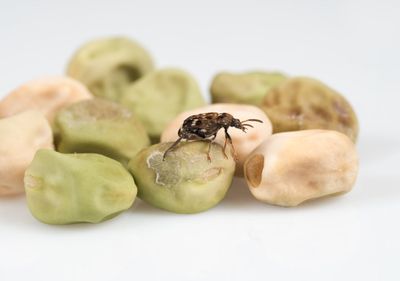What are Pea Weevils?
Pea weevil pests are small, black to brownish insects with a white zigzag running across the back. Bruchus pisorum overwinter in plant debris in the soil and then lay their eggs on the pea pods. Pea weevil larvae hatch and burrow into the pods and feed on the developing peas while adults munch on the blossoms. The resulting pea weevil damage on the pea crop renders it unfit for sale in the commercial sector and unappetizing for the home gardener. Not only does this pea weevil infestation affect the germination potential of developing peas, but in the commercial arena, costs many dollars separating and discarding infested pea pods.
Control of Pea Weevil
The control of pea weevil pest is of paramount importance in relation to the commercial pea crop industry and it may be of a high importance to the home gardener as well. Controlling pea weevils in the pea farm may be attained with the use of a dust mixture containing ¾ of 1 percent of rotenone. One to three dustings may be necessary to gain the upper hand on the pea weevil infestation at just the correct life cycle of the pea. The primary dusting should occur when the peas first begin to bloom, but before pods have set. Successive application should occur depending upon weevil migrations that may afflict the field after the first rotenone application. This same dusting procedure will work in the home garden with a hand duster and should be repeated at weekly intervals throughout the growing season. For the home gardener, however, the first order of business when controlling pea weevil infestations is to clean and dispose of any debris in the garden where the pests can potentially overwinter. Spent vines should be pulled and destroyed immediately post-harvest. The pulling of the vines before the peas are dry is the wisest course of action, although piling and burning will work just as well. Any that are left in the garden should be plowed underground 6-8 inches (15-20 cm.). This practice will prevent any eggs deposited from hatching or developing and infesting the pea crop the following year.
